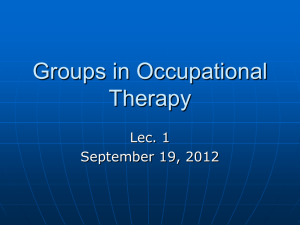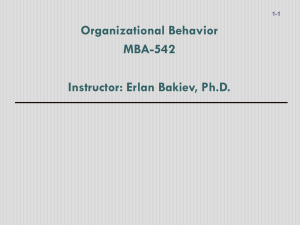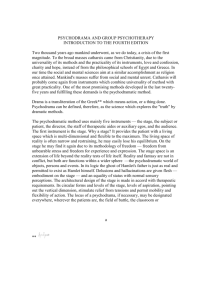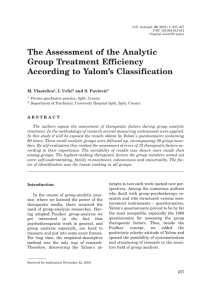Groups and Change
advertisement
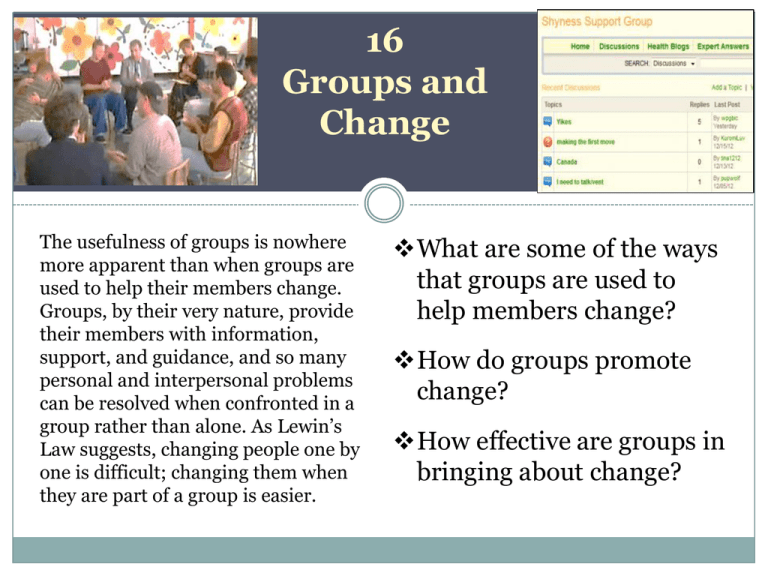
16 Groups and Change The usefulness of groups is nowhere more apparent than when groups are used to help their members change. Groups, by their very nature, provide their members with information, support, and guidance, and so many personal and interpersonal problems can be resolved when confronted in a group rather than alone. As Lewin’s Law suggests, changing people one by one is difficult; changing them when they are part of a group is easier. What are some of the ways that groups are used to help members change? How do groups promote change? How effective are groups in bringing about change? Group Approaches Sources of Change Effectiveness Therapeutic groups Universality & hope Empirical support Interpersonal learning groups Social learning Cautions Support groups Cohesion The value of groups Disclosure & catharsis Altruism Insight Case: The Bus Group (Turner, A. L., 2000). Lewin’s Law of Change “It is usually easier to change individuals formed into a group than to change any of them separately.” Basic “types” of therapeutic groups Therapeutic groups Interpersonal learning groups Support groups (mutual help groups) Therapeutic groups Group Psychoanalysis Gestalt Groups Types Psychodrama Interpersonal Group Psychotherapy Cognitive-behavioral therapy groups Group Psychoanalysis The First Committee Of The Vienna Psychoanalytical Society Freud’s discussed group processes in his book Group Psychology and the Analysis of Ego Freud did not conduct therapy in groups, but other analysts did Insight Corrective into recapitulation unconscious of conflicts early experiences of relationships Transference Catharsis to group members and therapist [Source: Berlin, 1922 Becker Maas, Library of Congress (124),(LC-USZ62-119779)] From Left to Right: Otto Rank, Sigmund Freud, Karl Abraham, Max Eitingon, Sàndor Ferenczi, Ernest Jones, Hans Sachs Gestalt Group Psychotherapy Gestalt group therapy is based on the work of Fritz Perls, who maintained people tend to fail to accept and integrate their experiences, thoughts, and emotions The Goal: To achieve phenomenological unity (a gestalt) When conducted in groups, Gestalt therapy makes use of exercises and role-playing methods (e.g., the hot seat, empty seat). Psychodrama Psychodrama involves acting out experiences in the group, role-playing, and imitation Jacob Moreno developed this method; he also explored early uses of social network analysis (sociometry) and founded the journal Sociometry (now titled Social Psychology Quarterly). Interpersonal Group Psychotherapy The most widely used method, interpersonal group therapy, uses the group as a “social microcosm” to help members learn about how they influence others and how others influence them. Irvin Yalom’s interactive process groups, for example, emphasize analysis of ongoing interactions in the group (a “here and now” orientation) by all members Cognitive-behavioral therapy groups Cognitive-behavior group therapy uses of behavioral methods developed in individual treatment settings with groups. Often used for more specific issues, such as phobias, depression, drug addiction, sexual offenses, and so on. Key Components: Behavioral contracts, modeling, behavior rehearsal, feedback Process Debriefing Groups Purpose: To reduce the negative mental health consequences of organizational-level or community-level trauma Processes: Group-level Process debriefing groups (or critical incident stress debriefing groups, or trauma/disaster groups) therapeutic coping processes, such as collective processing of experiences and reaffirmation of connections to survivors. Effectiveness: The effectiveness of these interventions is not yet known Interpersonal learning groups Early Forms • T-groups (Lewin) • Encounter groups • Sensitivity training groups Contemporary Approaches • Experiential learning • Skill-building retreats • Structured training groups Workshops, seminars, retreats, focusing on specific interpersonal skills or problems, often combine a group experience with analysis and reflection. Support groups Problem-specific: deal with a specific problem or concern, such as alcohol, physical illness Perspective-based: Often adopt a particular “perspective” on the issue and its causes (e.g., AA) Autonomous: little or no fee is charged for membership, and leaders are volunteers rather than professionals Interpersonal: members establish strong ties to each other Communal: group stresses community and sharing Varieties of Support (Mutual help) Groups Many support groups meet online, relying on computer-based communication to make connections among members and provide information. Group Approaches Sources of Therapeutic Effectiveness Change Factors Therapeutic groups Universality & hope Interpersonal learning groups Social learning Support groups Cohesion Disclosure & catharsis Altruism Insight Therapeutic Factors Universality and Hope • Groups (and social comparison) convince members of the universality of their problems, elevate their levels of hope, and instigate a shared, group-level identity. Social Learning • Groups facilitate observational learning (modeling of behaviors), interpersonal feedback, and guidance (direct instruction). Group Cohesion • Cohesion increases membership retention, improves communication, and increases influence of the group on the individual. Therapeutic Factors Self-disclosure • Groups become more intimate as members reveal private information about themselves. Catharsis • In supportive, high-trust groups, members can vent their strong, and this may reduce their stress. Altruism • Members experience increased selfconfidence when they help others and they gain insight into their personal qualities. Sources of Change Cohesion is generally viewed as a necessary condition for a successful thereapeutic group However, members most value universality, interpersonal learning, cohesion/support, and insight Group Approaches Sources of Change Evidence-based Treatments (EBTs) • Clinical procedures whose effectiveness has been documented through objective, scientifically rigorous research Are Group Treatments EBTs? • Research indicates that group approaches to treatment are generally as effective, if not more effective, than individual approaches. Effectiveness Empirical support Cautions The value of groups Source: http://www.apa.org/monitor/2012/11/power.aspx Empirical support Cautions Meta-analytic reviews are generally positive (Burlingame) Lieberman, Yalom, & Miles‘ classic study supported various methods Participants in many types of therapies rate groups approaches positively Interventions are more effective if consistent with both the emic and etic perspective of a cultural context Drop-outs (premature terminations, casualities (individuals harmed by the experience, and overhelping occur in groups, but the rates are known to be relatively low The value of groups Groups help their members define and confirm their values, beliefs, and identities. When individuals are beset by problems and uncertainties, groups offer reassurance, security, support, and assistance. Groups are places where people can learn new social skills and discover things about themselves and others. Group approaches are generally effective, but they do not work for everyone or for all types of psychological problems. Groups, too, can produce changes in members when other approaches have failed Group Approaches Sources of Change Effectiveness Therapeutic groups Universality & hope Empirical support Interpersonal learning groups Social learning Cautions Support groups Cohesion The value of groups Disclosure & catharsis Altruism Insight Case: The Bus Group (Turner, A. L., 2000).
